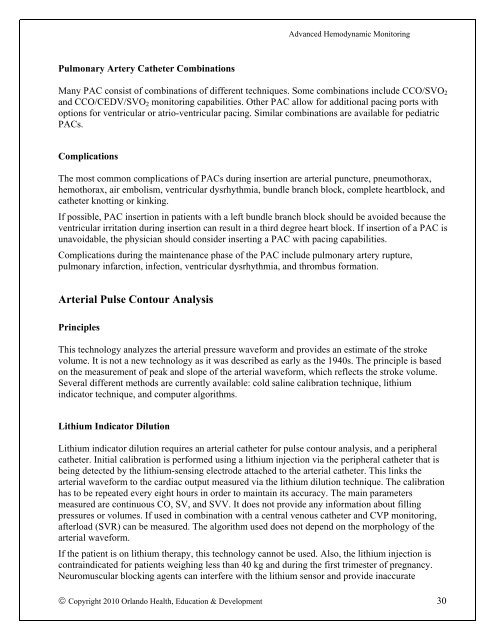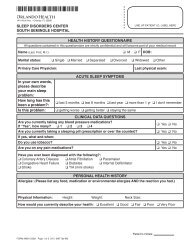Advanced Hemodynamics - Orlando Health
Advanced Hemodynamics - Orlando Health
Advanced Hemodynamics - Orlando Health
You also want an ePaper? Increase the reach of your titles
YUMPU automatically turns print PDFs into web optimized ePapers that Google loves.
<strong>Advanced</strong> Hemodynamic Monitoring<br />
Pulmonary Artery Catheter Combinations<br />
Many PAC consist of combinations of different techniques. Some combinations include CCO/SVO 2<br />
and CCO/CEDV/SVO 2 monitoring capabilities. Other PAC allow for additional pacing ports with<br />
options for ventricular or atrio-ventricular pacing. Similar combinations are available for pediatric<br />
PACs.<br />
Complications<br />
The most common complications of PACs during insertion are arterial puncture, pneumothorax,<br />
hemothorax, air embolism, ventricular dysrhythmia, bundle branch block, complete heartblock, and<br />
catheter knotting or kinking.<br />
If possible, PAC insertion in patients with a left bundle branch block should be avoided because the<br />
ventricular irritation during insertion can result in a third degree heart block. If insertion of a PAC is<br />
unavoidable, the physician should consider inserting a PAC with pacing capabilities.<br />
Complications during the maintenance phase of the PAC include pulmonary artery rupture,<br />
pulmonary infarction, infection, ventricular dysrhythmia, and thrombus formation.<br />
Arterial Pulse Contour Analysis<br />
Principles<br />
This technology analyzes the arterial pressure waveform and provides an estimate of the stroke<br />
volume. It is not a new technology as it was described as early as the 1940s. The principle is based<br />
on the measurement of peak and slope of the arterial waveform, which reflects the stroke volume.<br />
Several different methods are currently available: cold saline calibration technique, lithium<br />
indicator technique, and computer algorithms.<br />
Lithium Indicator Dilution<br />
Lithium indicator dilution requires an arterial catheter for pulse contour analysis, and a peripheral<br />
catheter. Initial calibration is performed using a lithium injection via the peripheral catheter that is<br />
being detected by the lithium-sensing electrode attached to the arterial catheter. This links the<br />
arterial waveform to the cardiac output measured via the lithium dilution technique. The calibration<br />
has to be repeated every eight hours in order to maintain its accuracy. The main parameters<br />
measured are continuous CO, SV, and SVV. It does not provide any information about filling<br />
pressures or volumes. If used in combination with a central venous catheter and CVP monitoring,<br />
afterload (SVR) can be measured. The algorithm used does not depend on the morphology of the<br />
arterial waveform.<br />
If the patient is on lithium therapy, this technology cannot be used. Also, the lithium injection is<br />
contraindicated for patients weighing less than 40 kg and during the first trimester of pregnancy.<br />
Neuromuscular blocking agents can interfere with the lithium sensor and provide inaccurate<br />
Copyright 2010 <strong>Orlando</strong> <strong>Health</strong>, Education & Development 30

















